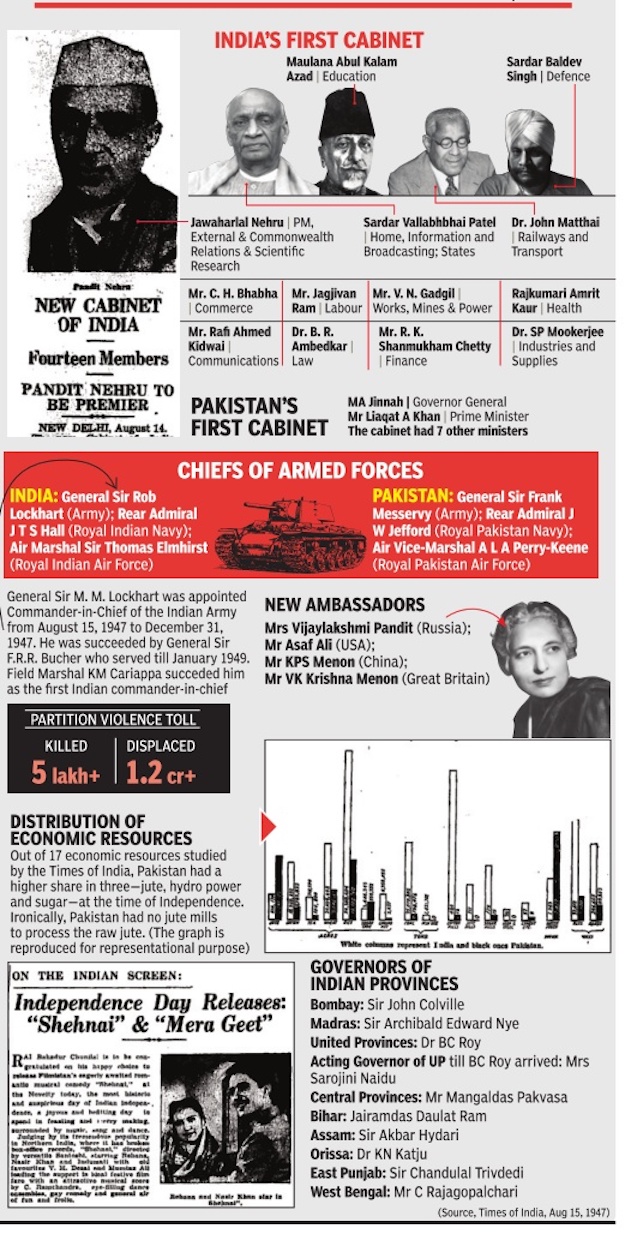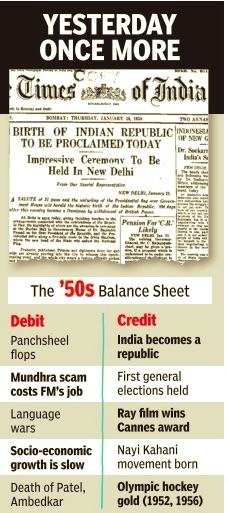India, A brief history: 1947 onwards
(→1947-67: a history of the early years) |
(→I) |
||
| Line 81: | Line 81: | ||
===I=== | ===I=== | ||
[http://epaperbeta.timesofindia.com/Article.aspx?eid=31808&articlexml=Why-Indias-Constitution-remains-a-guiding-light-for-15082017454037 Dipankar Gupta, Why India's Constitution remains a guiding light for the liberal world, August 15, 2017: The Times of India] | [http://epaperbeta.timesofindia.com/Article.aspx?eid=31808&articlexml=Why-Indias-Constitution-remains-a-guiding-light-for-15082017454037 Dipankar Gupta, Why India's Constitution remains a guiding light for the liberal world, August 15, 2017: The Times of India] | ||
| + | [[File: Hectic campaigning in Delhi before the first general election.jpg|Hectic campaigning in Delhi before the first general election; [http://epaperbeta.timesofindia.com/Gallery.aspx?id=15_08_2017_454_037_015&type=P&artUrl=Why-Indias-Constitution-remains-a-guiding-light-for-15082017454037&eid=31808 August 15, 2017: The Times of India]|frame|500px]] | ||
| + | [[File: The 1950s Balance Sheet.jpg|The 1950s Balance Sheet; [http://epaperbeta.timesofindia.com/Gallery.aspx?id=15_08_2017_454_037_015&type=P&artUrl=Why-Indias-Constitution-remains-a-guiding-light-for-15082017454037&eid=31808 August 15, 2017: The Times of India]|frame|500px]] | ||
''A decade of nation-building under Jawaharlal Nehru provided an industrial base, a pool of scientific talent, and a legal frame for wide swathe of reforms'' | ''A decade of nation-building under Jawaharlal Nehru provided an industrial base, a pool of scientific talent, and a legal frame for wide swathe of reforms'' | ||
Revision as of 23:07, 16 August 2017






This is a collection of articles archived for the excellence of their content. |
Contents |
1947: Partition; the first cabinets
See graphic: State of two then newly independent nations, India and Pakistan, as on August 15, 1947

1947-67: a history of the early years
INDIA: AN UNAUTHORISED BIOGRAPHY PEOPLE, EVENTS, POLICIES, Aug 15 2017: The Times of India 1 Words to live by
Among the 20th century's stirring speeches is Nehru's `Tryst with Destiny' address to the Constituent Assembly at midnight, August 14, 1947, marking the transition to freedom. Laying out the vision for free India in 820 words, India's first PM talked of peace and service, foregrounding the themes of welfare and security in public discourse.
2 The Constitution's architect
A radical thinker rarely in agreement with Gandhians and Congress, B R Ambedkar was still appointed law minister in Nehru's first cabinet and tasked with raising a framework for modern India. He chose to underpin it with the principles of equality and justice, placing emphasis on individual rights rather than traditions, communities, and ideology. The idea of a strong Centre within a federal system of governance were also underscored through his arguments.A rare photo of Dr Ambedkar after his conversion to Buddhism
3 Bhasha battles
The language question loomed large much before states were reorganised on linguistic lines.
From the 1930s, Periyar opposed Rajaji's efforts to popularise Hindi in Tamil Nadu (Madras Presidency), and later DMK turned the stir into a movement that swept them to power.
4 India's heroes
Raj-Dilip-Dev: The troika that lorded over Bombay cinema and the nation's heart in the 1950s-60s. Dilip Kumar typified bottled, moody passion; Dev Anand was the urbane, debonair male; Raj Kapoor, the heart-of-gold, Chaplinesque hero in Nehruvian movies with songs (Awara hoon, Mera joota hai Japani) that became timeless anthems.
DID YOU KNOW?
Raj & Dilip acted together in Andaz. Dilip & Dev were lead performers in Insaniyat. Raj & Dev never shared the same screen space.
5 Song of the road
Pather Panchali, Satyajit Ray's lyrical debut feature (1955), put India on the map of world cinema and became the benchmark for every aspiring Indian auteur.
6 Road maps
India had 12 five-year plans for the economy since 1951.Although scrapped in favour of Niti Aayog's three-year action plans, the USSR-inspired plans are the reason one can drive from Kashmir to Kanyakumari without starving on the way.
7 Rise of the Reds
In 1957, the first-ever elected communist government was formed in Kerala with EMS becoming the chief minister. Invoking Article 356, PM Nehru dismissed the EMS govt in 1959, after it initiated radical land reforms and an overhaul of the education system.
8 Temples of modern India
Massive hydel projects (Bhakra Nangal, Hirakud) built in the 1950s-60s became emblems of Nehruvian development.
They set the stage for the Green Revolution but lost their sheen by the 1990s, and activists campaigned actively against them.Picture of Hirakud Dam on a Rs 100 note
9 At war
The Indian Army, its reputation burnished by WWII, was handed a morale-wrecking defeat in the Himalayas by China's PLA which came with overwhelming numbers and superior firepower.The Army's prestige was crushed, as was Nehru's spirit.
10 Peasants, workers unite
The summer of '67 uprising by peasants and tea garden workers in the picture-postcard north Bengal village of Naxalbari created the template for armed, radical Left movements that continue to thrive in swathes of India Ignored.Busts of Lenin, Stalin, Mao and Charu Mazumdar in Naxalbari
1947-64: the building of institutions
I


A decade of nation-building under Jawaharlal Nehru provided an industrial base, a pool of scientific talent, and a legal frame for wide swathe of reforms
The first two decades after Independence belonged to Jawaharlal Nehru. He epito mised India's gigantic effort to become modern, self-re liant and remain together. There were many detractors of these efforts for they were sure that a country so divided by language and religion, racked by ancient prejudices and as poor as some of the poorest in the world, had no chance to survive.
Yet, miraculously, India survived and slowly fears of its disintegration reced slowly fears of its disintegration receded. It is not as if there were no anxious moments. Maharashtra wanted a state of its own and, before it, so did the Telu gu speaking people of the erstwhile state of Madras.The government dithered on this in the fear that this was the beginning of the dreaded Balkanisation threat that they were warned against.
However, as the States Reorganisa tion Commission finally resolved these demands it became clear that neither the newly-formed Andhra Pradesh, nor Maharashtra had any intention of separating from India. The ethos of the National Movement was stronger than what some of their leaders gave it credit for. What is more, it established the legitimacy of a state being governed in its own language -a provision that Sri Lanka, for example, failed to provide and suffered as a consequence.
What helped resolve many of these early difficulties was the fact that India had crafted a Constitution which became ef fective in 1950 and is regarded, even today , as one of the leading liberal documents of the democratic world. It established basic rights and liberties and also de-legitimised some of the ancient practices among Hindus which were unfair to women and debased many on the basis of caste.
This was a social revolution at one stroke. Doubtless, there were many leading figures who were by Nehru's side in this endeavour, Dr Ambedkar, principally , but it was Nehru's political acumen and legislative skills that eventually saw these provisions as law. He simultaneously moved against landlordism and this invited a strong backlash from entrenched quarters, but Nehru won the day .
There were other irons in the fire as well. Nehru initiated an entirely innovative economic policy that was clearly not communist or blatantly capitalist. He believed that a mixed economy was the best way for India to overcome the initial difficulties of becoming a modern industrial state.
He pushed for a strong public sector which would provide steel, energy and heavy equipment and establish the basis for sustained economic entrepreneurship in the years to come. Though the public sector is in much disrepute today, it can hardly be doubted that the infrastructural impetus that Nehru started allowed for a modern economy to develop.
All economies need knowledge, high ly skilled and technical at that, to keep them humming. There is little doubt that if India can boast of being a hub in today's information technology sector, or of producing world-class engineers and of a high-powered scientific body, it is Nehru who deserves the credit. He had the wisdom and foresight to set up the Indian Institute of Science, the IITs, the AIIMS and the IIMs, to name a few.
Alongside, in the field of culture, the Lalit Kala Akademi and Sangeet Kala Akademi and the Film and Television Institute of India were also established at his insistence. It was an all-out, four square thrust to bring India into the modern world of knowledge, sciences and the arts. Such was the vision of the man.
In foreign policy, Nehru's contribution was not nearly as singular and suf fered several setbacks, some of them during his lifetime. Both the USSR and the US were suspicious of the Non-Aligned Movement. The former thought we were being manipulated by the communists and Stalin believed that this was just a thinly disguised US plot. The India-China War of 1962 robbed all of the starch in the Non-Aligned Movement and the India-China 1952 Panchsheel Policy .
When Nehru died, he was a vastly disappointed man not just because his personal charisma had suffered a massive erosion with the 1962 China War, but also because his hopes that the public sector would man the commanding heights of the economy was not getting anywhere fast.
But, by then India was a stable, democratic republic and the fear that it would collapse was belied. Nehru showed his critics that those who ran the government were not people of straw, as often accused. Truly, this was nation building as good as one can get, for which reason that period can justifiably be called the Nehruvian years.